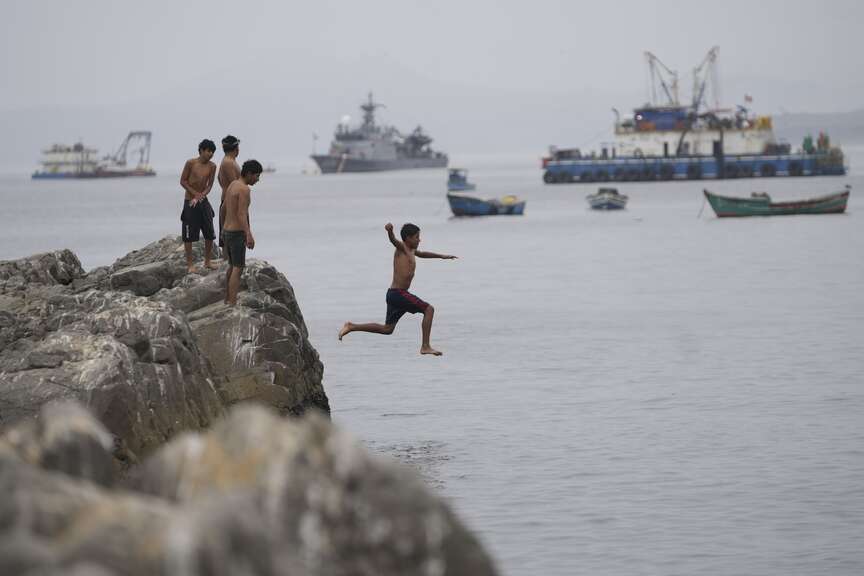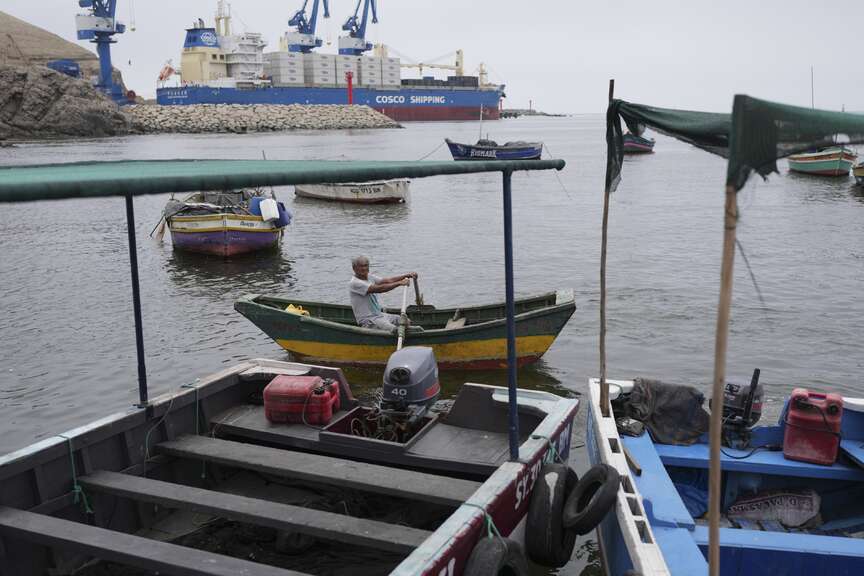A worker walks past a sign presenting the Asia-Pacific Economic Cooperation (APEC) summit outside the Ministry of Culture in Lima, Peru, Tuesday, Nov. 12, 2024. (AP Photo/Fernando Vergara)
   Â  A cargo ship sits in a Chinese-funded port in Chancay, Peru, Tuesday, Nov. 12, 2024. (AP Photo/Silvia Izquierdo)
 A cargo ship sits in a Chinese-funded port in Chancay, Peru, Tuesday, Nov. 12, 2024. (AP Photo/Silvia Izquierdo)
   Â  Air Force members fix the red carpet before the arrival of Vietnam’s President Luong Cuong in Lima, Peru, for the Asia-Pacific Economic Cooperation (APEC) summit, Tuesday, Nov. 12, 2024. (AP Photo/Guadalupe Pardo)
 Air Force members fix the red carpet before the arrival of Vietnam’s President Luong Cuong in Lima, Peru, for the Asia-Pacific Economic Cooperation (APEC) summit, Tuesday, Nov. 12, 2024. (AP Photo/Guadalupe Pardo)
   Â  A youth jumps into the water near a Chinese-funded port in Chancay, Peru, Tuesday, Nov. 12, 2024. (AP Photo/Silvia Izquierdo)
 A youth jumps into the water near a Chinese-funded port in Chancay, Peru, Tuesday, Nov. 12, 2024. (AP Photo/Silvia Izquierdo)
   Â  A cargo ship sits in a Chinese-funded port in Chancay, Peru, Tuesday, Nov. 12, 2024. (AP Photo/Silvia Izquierdo)
 A cargo ship sits in a Chinese-funded port in Chancay, Peru, Tuesday, Nov. 12, 2024. (AP Photo/Silvia Izquierdo)
   Â  A fisherman travels on a boat near a Chinese-funded port construction in Chancay, Peru, Tuesday, Nov. 12, 2024. (AP Photo/Silvia Izquierdo)
 A fisherman travels on a boat near a Chinese-funded port construction in Chancay, Peru, Tuesday, Nov. 12, 2024. (AP Photo/Silvia Izquierdo)
 Â
   Â
 Â A cargo ship sits in a Chinese-funded port in Chancay, Peru, Tuesday, Nov. 12, 2024. (AP Photo/Silvia Izquierdo)
 A cargo ship sits in a Chinese-funded port in Chancay, Peru, Tuesday, Nov. 12, 2024. (AP Photo/Silvia Izquierdo)   Â
 Â Air Force members fix the red carpet before the arrival of Vietnam’s President Luong Cuong in Lima, Peru, for the Asia-Pacific Economic Cooperation (APEC) summit, Tuesday, Nov. 12, 2024. (AP Photo/Guadalupe Pardo)
 Air Force members fix the red carpet before the arrival of Vietnam’s President Luong Cuong in Lima, Peru, for the Asia-Pacific Economic Cooperation (APEC) summit, Tuesday, Nov. 12, 2024. (AP Photo/Guadalupe Pardo)   Â
 Â A youth jumps into the water near a Chinese-funded port in Chancay, Peru, Tuesday, Nov. 12, 2024. (AP Photo/Silvia Izquierdo)
 A youth jumps into the water near a Chinese-funded port in Chancay, Peru, Tuesday, Nov. 12, 2024. (AP Photo/Silvia Izquierdo)   Â
 Â A cargo ship sits in a Chinese-funded port in Chancay, Peru, Tuesday, Nov. 12, 2024. (AP Photo/Silvia Izquierdo)
 A cargo ship sits in a Chinese-funded port in Chancay, Peru, Tuesday, Nov. 12, 2024. (AP Photo/Silvia Izquierdo)   Â
 Â A fisherman travels on a boat near a Chinese-funded port construction in Chancay, Peru, Tuesday, Nov. 12, 2024. (AP Photo/Silvia Izquierdo)
 A fisherman travels on a boat near a Chinese-funded port construction in Chancay, Peru, Tuesday, Nov. 12, 2024. (AP Photo/Silvia Izquierdo) Â
Source link : http://www.bing.com/news/apiclick.aspx?ref=FexRss&aid=&tid=6735b56f10f043b18dbee9fe04478fe3&url=https%3A%2F%2Fwww.arkansasonline.com%2Fnews%2F2024%2Fnov%2F14%2Felection-loss-darkens-apec-summit-for-biden%2F&c=6171085628256775967&mkt=en-us
Author :
Publish date : 2024-11-13 19:02:00
Copyright for syndicated content belongs to the linked Source.












